Developer Guide
- Setting up, getting started
- Design
- Implementation
- Documentation, logging, testing, configuration, dev-ops
- Appendix: Requirements
- Appendix: Instructions for manual testing
Setting up, getting started
Refer to the guide Setting up and getting started.
Design
Architecture

The Architecture Diagram given above explains the high-level design of the App. Given below is a quick overview of each component.
.puml files used to create diagrams in this document can be found in the diagrams folder. Refer to the PlantUML Tutorial at se-edu/guides to learn how to create and edit diagrams.
Main has two classes called Main and MainApp. It is responsible for,
- At app launch: Initializes the components in the correct sequence, and connects them up with each other.
- At shut down: Shuts down the components and invokes cleanup methods where necessary.
Commons represents a collection of classes used by multiple other components.
The rest of the App consists of four components.
-
UI: The UI of the App. -
Logic: The command executor. -
Model: Holds the data of the App in memory. -
Storage: Reads data from, and writes data to, the hard disk.
Each of the four components,
- defines its API in an
interfacewith the same name as the Component. - exposes its functionality using a concrete
{Component Name}Managerclass (which implements the corresponding APIinterfacementioned in the previous point.
For example, the Logic component (see the class diagram given below) defines its API in the Logic.java interface and exposes its functionality using the LogicManager.java class which implements the Logic interface.

How the architecture components interact with each other
The Sequence Diagram below shows how the components interact with each other for the scenario where the user issues the command delete_person s/1.

The sections below give more details of each component.
UI component

API :
Ui.java
The UI consists of a MainWindow that is made up of parts e.g.CommandBox, ResultDisplay, PersonListPanel, StatusBarFooter etc. All these, including the MainWindow, inherit from the abstract UiPart class.
The UI component uses JavaFx UI framework. The layout of these UI parts are defined in matching .fxml files that are in the src/main/resources/view folder. For example, the layout of the MainWindow is specified in MainWindow.fxml
The UI component,
- Executes user commands using the
Logiccomponent. - Listens for changes to
Modeldata so that the UI can be updated with the modified data.
Logic component

API :
Logic.java
-
Logicuses theAddressBookParserclass to parse the user command. - This results in a
Commandobject which is executed by theLogicManager. - The command execution can affect the
Model(e.g. adding a person). - The result of the command execution is encapsulated as a
CommandResultobject which is passed back to theUi. - In addition, the
CommandResultobject can also instruct theUito perform certain actions, such as displaying help to the user.
Given below is the Sequence Diagram for interactions within the Logic component for the execute("delete_person s/3") API call.
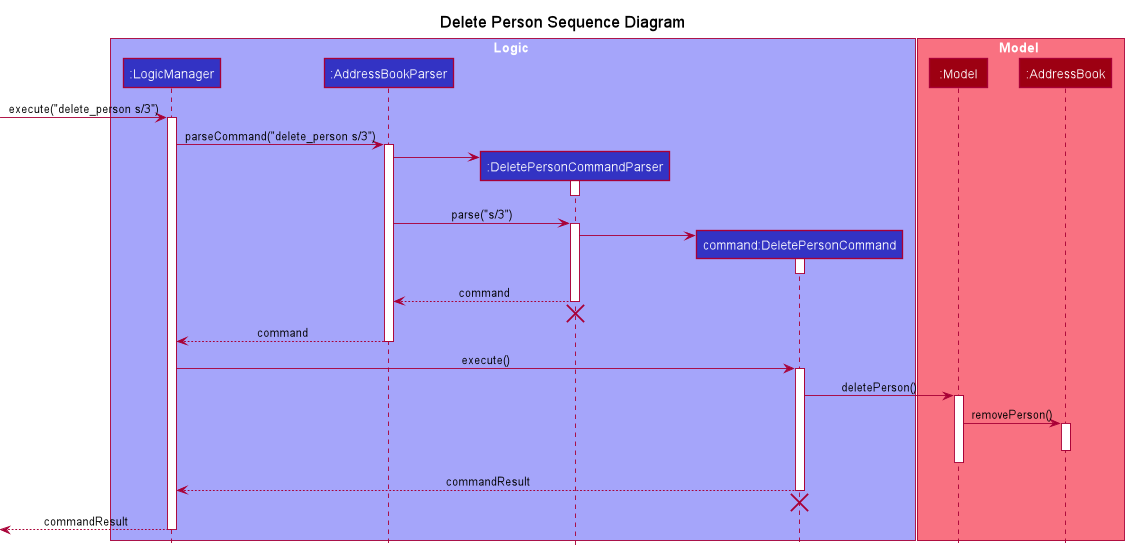
DeletePersonCommandParser and DeletePersonCommand should end at the destroy marker (X) but due to a limitation of PlantUML, the lifeline reaches the end of diagram.
Model component

API : Model.java
The Model,
- stores a
UserPrefobject that represents the user’s preferences. - stores the address book data.
- exposes an unmodifiable
ObservableList<Person>that can be ‘observed’ e.g. the UI can be bound to this list so that the UI automatically updates when the data in the list change. - does not depend on any of the other three components.
Tag list in the AddressBook, which Person references. This allows AddressBook to only require one Tag object per unique Tag, instead of each Person needing their own Tag object.
Storage component

API : Storage.java
The Storage component,
- can save
UserPrefobjects in json format and read it back. - can save the address book data in json format and read it back.
Common classes
Classes used by multiple components are in the seedu.addressbook.commons package.
Implementation
This section describes some noteworthy details on how certain features are implemented.
Add person feature
Current Implementation
The add person feature allows the user to add either a student or a tutor to EzManage
The add person feature is facilitated by UniquePersonList. This list is stored internally in AddressBook as persons.
UniquePersonList has a method called addPerson(Person p) which adds a Person to its list of Person. This person could be a Tutor or a Student depending on its personType attribute.
This operation is exposed in the Model interface as Model#addPerson(Person person)
Given below is an example usage scenario and how the add person mechanism behaves at each step.
Step 1: The user executes add_person pt/student …. The LogicManager takes in the string command and calls AddressBookParser#parseCommand(String userInput).
Step 2: The parseCommand method passes the user input to AddPersonCommandParser#parse(String args) which returns an AddPersonCommand object. This addPersonCommand object has a reference to a Person which could be either Student or Tutor
Step 3: The LogicManager then executes the AddPersonCommand which calls the Model#addPerson(Person person) method.
Step 4: The Model adds the new Person to UniquePersonList in AddressBook and returns a CommandResult
Step 5: The CommandResult is then displayed on the UI
The sequence for the example scenario can be found below:

Add session feature
Current Implementation
The add session feature is facilitated by SessionList. It is stored internally in AddressBook as sessions. It implements the following relevant operations:
-
SessionList#add(Session toAdd)— Adds the given session to the current list of sessions
This operation is exposed in the Model interface as Model#addSession(Session session).
Given below is an example usage scenario and how the add session mechanism behaves at each step.
Step 1: The user executes add_session d/Saturday … command to add a new session. The LogicManager calls AddressBookParser#parseCommand(String userInput).
Step 2: The parseCommand method passes the user input to AddSessionCommandParser#parse(String args) which returns an AddSessionCommand object.
Step 3: The LogicManager then executes the AddSessionCommand which calls the Model#addSession(Session session) method.
Step 4: The Model adds the new session to sessions in AddressBook and returns a CommandResult.
Step 5: The CommandResult is then displayed on the UI.
The sequence for the example scenario can be found below:

AddSessionCommandParser and AddSessionCommand should end at the destroy marker (X) but due to a limitation of PlantUML, the lifeline reaches the end of diagram.
Assign person feature
Current Implementation
The assign feature is able to assign sessionId to the list of sessions in a Person. This person can either be a Student or a Tutor.
Likewise, studentId and tutorId will be assigned to the list of students and tutor attribute of a session respectively.
Given below is an example usage scenario and how the assign command behaves at each step.
Step 1 : The user executes assign s/1 t/1 c/1 command to assign student s/1 and tutor t/1 to session c/1The LogicManager takes in the user input the calls AddressBookParser#parseCommand(String userInput)
Step 2: The AddressBookParser then calls AssignCommandParser.parse(String args) that returns a AssignCommand. This AssignCommand will be return back to LogicManager
Step 3: LogicManager then calls AssignCommand#execute(). In this method, ÀssignCommand calls internal methods getStudents() and getTutor()to check if provided studentId and tutorId are valid inputs. Once checked, AssignCommand calls internal methods assignTutor() and assignStudents which updates the provided student, tutor and session in both UniquePersonList and SessionList.
Step 4: A CommandResult is returned
Step 5: The CommandResult is then displayed on the UI.
The sequence for the example scenario can be found below:
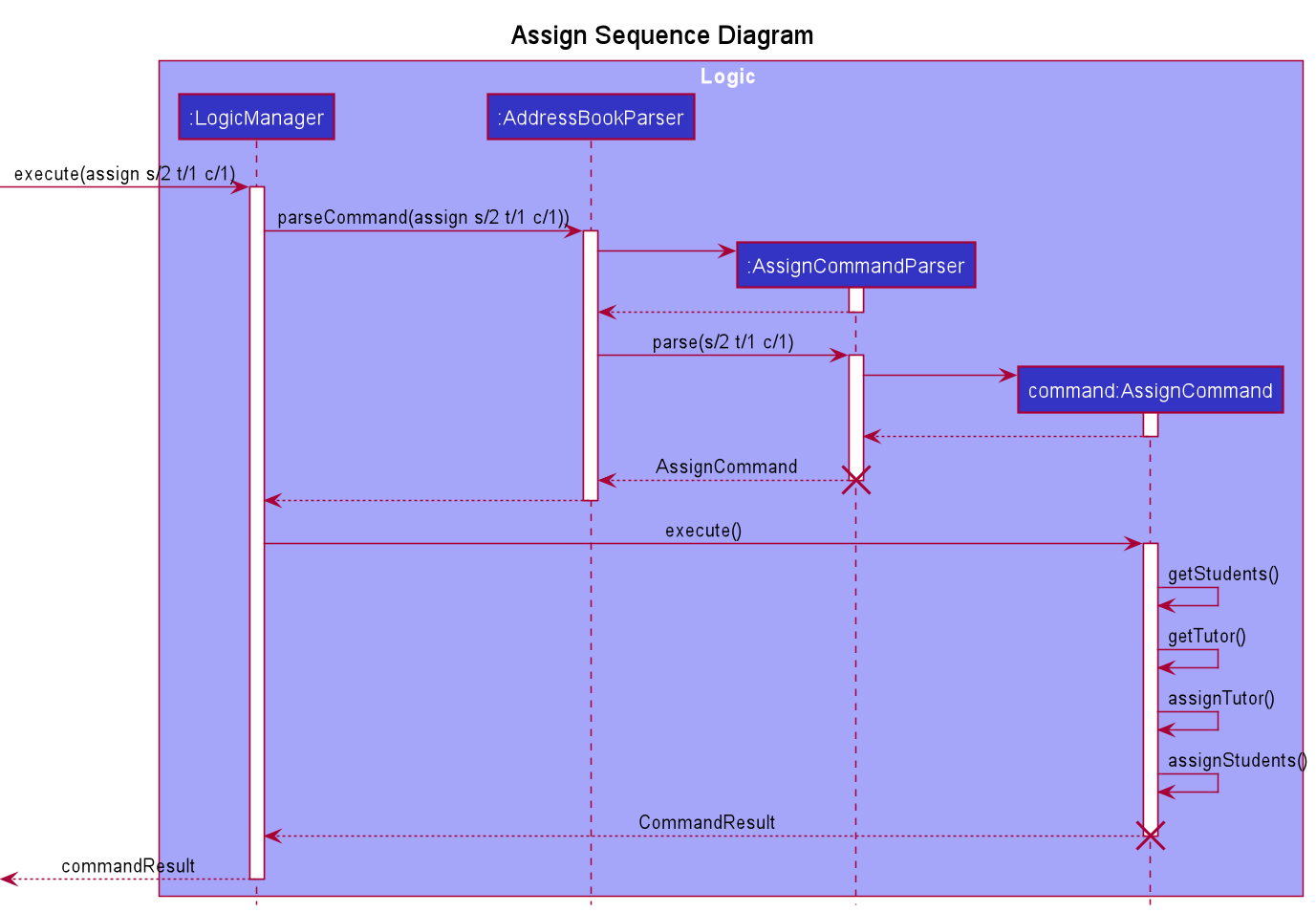
Unassign person feature
Current Implementation
The unassign feature utilises defensive programming to ensure that the tutor and students attributes of the session correspond with those persons’ sessions attribute.
Given below is an example usage scenario and how the unassign command behaves at each step.
Step 1: The user executes unassign s/1 c/1 command to unassign student s/1 from session c/1. The LogicManager calls AddressBookParser#parseCommand(String userInput).
Step 2: The parseCommand method passes the user input to UnassignCommandParser#parse(String args) which returns an UnassignCommand object.
Step 3: The LogicManager then executes the UnassignCommand.
Step 4: The UnassignCommand calls the Person#removeSession(SessionID session) to remove the session from the student s/1’s list, and Session#unassignStudent(PersonId student) to remove the student from the session c/1’s list.
Step 5: A CommandResult object is returned and displayed on the UI.
The sequence for the example scenario can be found below:
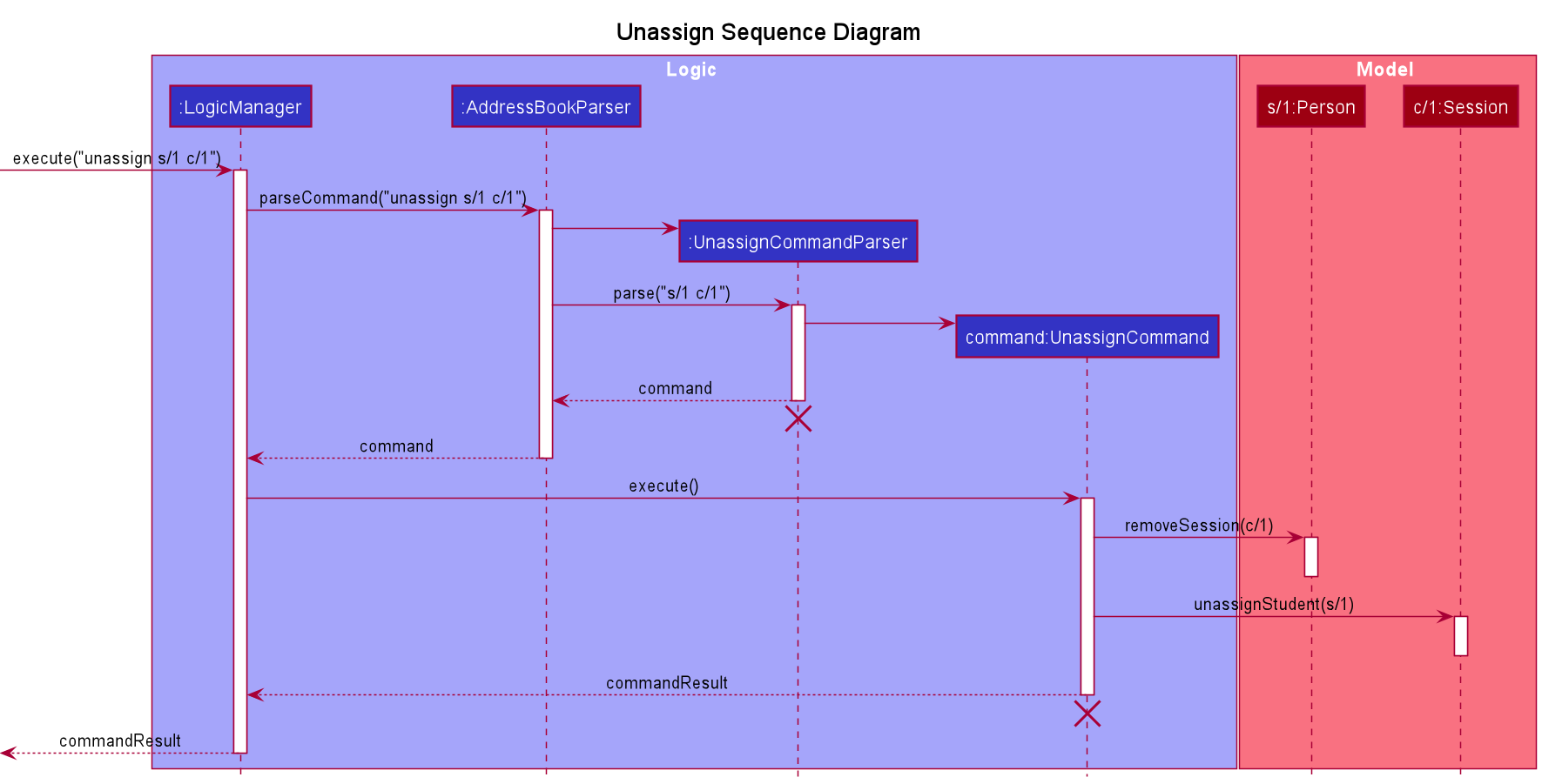
UnassignCommandParser and UnassignCommand should end at the destroy marker (X) but due to a limitation of PlantUML, the lifeline reaches the end of diagram.
Delete person feature
Current Implementation
The delete person feature is facilitated by UniquePersonList. It is stored internally in AddressBook as persons. It implements the following relevant operations:
-
UniquePersonList#remove(Person toRemove)- Removes the given person (student or tutor) from the current list of persons
This operation is exposed in the Model interface as Model#deletePerson(Person target).
Given below is an example usage scenario and how the delete person mechanism behaves at each step.
Step 1: The user launches the application for the first time. The AddressBook will contain a UniquePersonList.
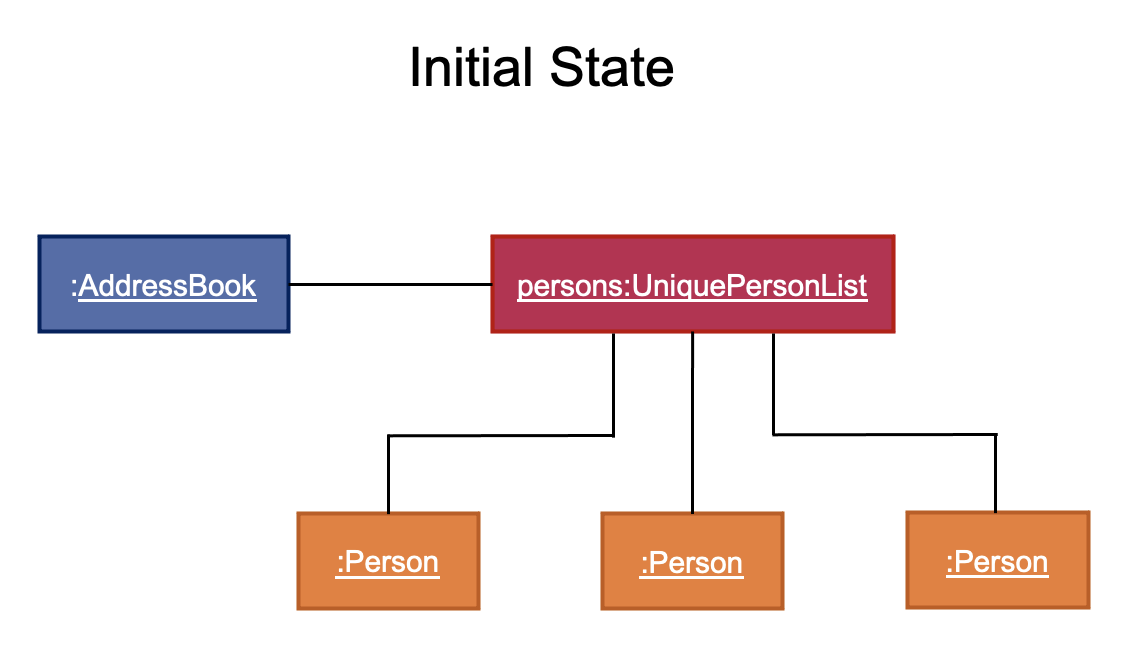
Step 2: The user executes delete_person s/3 command to remove the specified person. The LogicManager calls AddressBookParser#parseCommand(String userInput).
Step 3: The parseCommand method passes the user input to DeletePersonCommandParser#parse(String args) which returns a DeletePersonCommand object.
Step 4: The LogicManager then executes the DeletePersonCommand which calls the Model#deletePerson(Person target) method.
Step 5: The Model calls AddressBook#removePerson(Person key).
Step 6: The Model removes the specified person from persons in AddressBook and returns a commandResult.

Step 7: The commandResult is then displayed on the UI.
The sequence for the example scenario can be found below:

DeletePersonCommandParser and DeletePersonCommand should end at the destroy marker (X) but due to a limitation of PlantUML, the lifeline reaches the end of diagram.
Delete session feature
Current Implementation
The delete session feature is facilitated by SessionList. It is stored internally in AddressBook as sessions. It implements the following relevant operations:
-
SessionList#remove(Session toRemove)- Removes the given session from the current list of sessions.
This operation is exposed in the Model interface as Model#deleteSession(Session sessionToDelete).
Given below is an example usage scenario and how the delete session mechanism behaves at each step.
Step 1: The user launches the application for the first time. The AddressBook will contain a SessionList.
Step 2: The user executes delete_session c/1 command to remove the specified session. The LogicManager calls AddressBookParser#parseCommand(String userInput).
Step 3: The parseCommand method passes the user input to DeleteSessionCommandParser#parse(String args) which returns a DeleteSessionCommand object.
Step 4: The LogicManager then executes the DeleteSessionCommand which calls the Model#deleteSession(Session sessionToDelete) method.
Step 5: The Model calls AddressBook#removeSession(Session key).
Step 6: The Model removes the specified session from sessions in AddressBook and returns a CommandResult.
Step 7: A CommandResult object is returned and displayed on the UI.
The sequence for the example scenario can be found below:
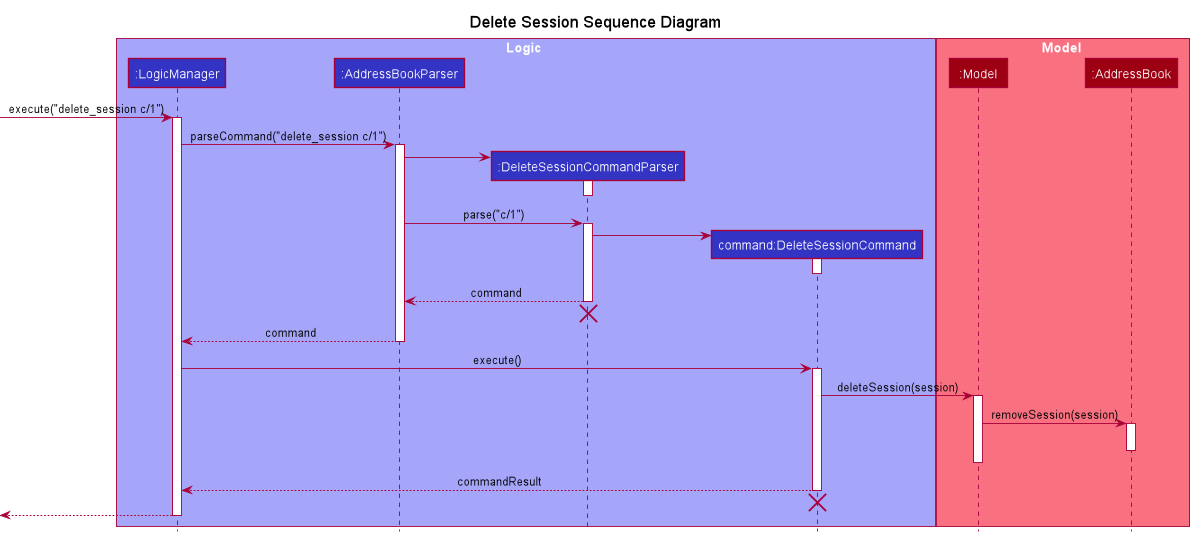
DeleteSessionCommandParser and DeleteSessionCommand should end at the destroy marker (X) but due to a limitation of PlantUML, the lifeline reaches the end of diagram.
Edit session feature
Current Implementation
The edit session feature is facilitated by SessionList. It is stored internally in AddressBook as sessions. It implements the following relevant operations:
-
SessionList#setSession(Session target, Session editedSession)— Replaces the target session in the current list of sessions with the edited session.
This operation is exposed in the Model interface as Model#setSession(Session sessionToEdit, Session editedSession).
Given below is an example usage scenario and how the edit session mechanism behaves at each step.
Step 1: The user executes edit_session c/2 d/Monday ts/12:00 to 13:00 command to edit the specified session. The LogicManager calls AddressBookParser#parseCommand(String userInput).
Step 2: The parseCommand method passes the user input to EditSessionCommandParser#parse(String args).
Step 3: An EditSessionDescriptor object is created and used to return an EditSessionCommand object.
Step 4: The LogicManager then executes the EditSessionCommand which calls the Model#setSession(Session sessionToEdit, Session editedSession) method.
Step 5: The Model replaces the specified session sessionToEdit in sessions in AddressBook with the edited session editedSession and returns a CommandResult.
Step 6: The CommandResult is then displayed on the UI.
The sequence for the example scenario can be found below:
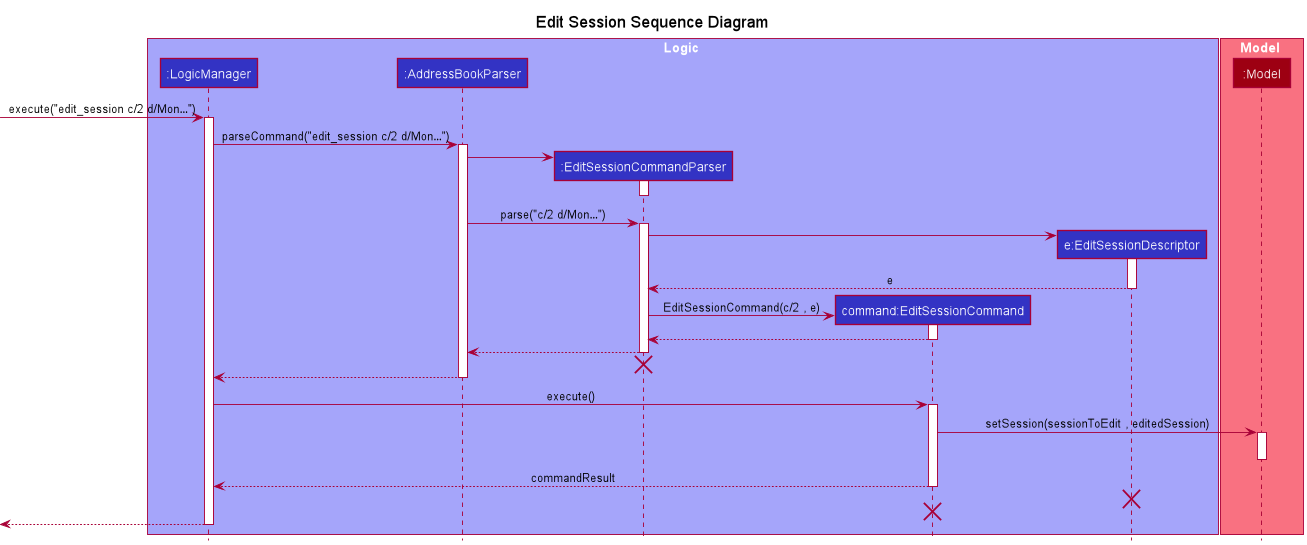
EditSessionCommandParser, EditSessionCommand and EditSessionDescriptor should end at the destroy marker (X) but due to a limitation of PlantUML, the lifeline reaches the end of diagram.
View person feature
Current Implementation
The view person feature requires the personID of the student or tutor, and
displays the relevant information belonging to the person under that specified ID.
As the user enters the command word view_person, the ViewCommandParser will verify
if a personID has been provided, and an error is thrown if otherwise. With the given personID,
a PersonIdPredicate will be created, and subsequently a ViewPersonCommmand object will be created.
The ViewPersonCommand class inherits from the Command abstract class, and it implements the execute()
class where it will use the PersonIdPredicate to update the model with the filtered list.
Given below is an example usage scenario and how the view person merchanism behaves at each step.
Step 1. The user launches the application and executes view_person s/1 command to view student with personID s/1.
Step 2. The parseCommand method under AddressBookParser class passes the user input to ViewCommandParser.
Step 3. The ViewCommandParser verifies that a valid personID has been provided and throw an exception if otherwise.
The parser then return a ViewPersonCommand object using the PersonIdPredicate created from the personID.
Step 4. The LogicManager then executes the ViewPersonCommand.
Step 5. The VierPersonCommand updates the model by calling Model#updateFilteredPersonList using the PersonIdPredicate created previously.
Step 6. A CommandResult object is returned and displayed on the UI.
The following activity diagram illustrates what happens when a user executes a view person command:

Documentation, logging, testing, configuration, dev-ops
Appendix: Requirements
Product scope
Target user profile:
- has a need to manage a significant number of student contacts
- has a need to allocate classes and teachers in a tuition center
- prefer desktop apps over other types
- can type fast
- prefers typing to mouse interactions
- is reasonably comfortable using CLI apps
Value proposition: manage contacts and allocations faster than a typical mouse/GUI driven app
User stories
Priorities: High (must have) - * * *, Medium (nice to have) - * *, Low (unlikely to have) - *
| Priority | As a … | I want to … | So that I can… |
|---|---|---|---|
* * * |
manager | add a new tutor | |
* * * |
manager | add a new student | |
* * * |
manager | add a new class slot with a specified subject and time frame | so that I am able to allocate students and tutors correctly |
* * * |
manager | delete a student | remove students that are no longer enrolled in the tuition center |
* * * |
manager | delete a tutor | remove tutors that are no longer working for the tuition center |
* * * |
manager | view the full list of tutors | |
* * * |
manager | view the full list of students | |
* * * |
manager | view the full list of classes | |
* * * |
manager | view a specific tutor’s details | |
* * * |
manager | view a specific student’s details | |
* * * |
manager | allocate a tutor to a specific class | |
* * * |
manager | allocate a student to a specific class | |
* * |
manager | delete a class | remove classes that are no longer available |
* * |
manager | edit tutor information | ensure tutor information are up to date |
* * |
manager | edit student information | ensure student information are up to date |
Use cases
(For all use cases below, the System is the EzManage and the Actor is the user, unless specified otherwise)
Use case: Add a person
MSS
- User requests to add a tutor or student in the list
-
EzManage adds the Person
Use case ends
Extensions
-
1a. The given tutor/student information is already exist in the list
- 1a1. EzManage shows an error message.
Use case ends.
Use case: Add a class
MSS
- User requests to add a class to the database
-
EzManage adds the class
Use case ends
Use case: Delete a student
MSS
- User requests to delete a specific student in the list of persons
-
EzManage deletes the student
Use case ends.
Extensions
-
1a. The given ID is invalid.
- 1a1. EzManage shows an error message.
Use case ends.
-
1b. The given ID is a person who is currently assigned to a session.
- 1b1. EzManage shows an error message, informing user to unassign the person from all of his/her sessions, before he/she can be deleted.
Use case ends.
Use case: View an individual person
MSS
- User requests to view a specific tutor/student in the list according to person ID
-
EzManage shows the person’s details and the classes assigned to the person
Use case ends.
Extensions
-
1a. The given index is in the wrong format.
-
1a1. EzManage shows an error message and show the proper usage of the command.
Use case resumes at step 2.
-
-
1b. The given index cannot be found in the address book.
-
1a1. EzManage shows an error message.
Use case ends.
-
Non-Functional Requirements
- Should work on any mainstream OS as long as it has Java
11or above installed. - Should be able to hold up to 1000 persons without a noticeable sluggishness in performance for typical usage.
- A user with above average typing speed for regular English text (i.e. not code, not system admin commands) should be able to accomplish most of the tasks faster using commands than using the mouse.
- Application should be scalable in the sense of adding more entities in the future
- Reliability, application should not crash and handles exception properly
Glossary
- Mainstream OS: Windows, Linux, Unix, OS-X
- Private contact detail: A contact detail that is not meant to be shared with others
Appendix: Instructions for manual testing
Given below are instructions to test the app manually.
Launch and shutdown
-
Initial launch
-
Download the jar file and copy into an empty folder
-
Double-click the jar file
Expected: Shows the GUI with a set of sample contacts. The window size may not be optimum.
-
-
Saving window preferences
-
Resize the window to an optimum size. Move the window to a different location. Close the window.
-
Re-launch the app by double-clicking the jar file.
Expected: The most recent window size and location is retained.
-
Deleting a person
-
Deleting a person
-
Prerequisites: Know a valid person ID.
-
Test case:
delete_person s/1
Assumption:s/1is a valid person ID.
Expected: Person with the IDs/1is deleted from the person list. Details of the deleted contact shown in the status message. -
Test case:
delete_person t/0
Assumption:t/0is an invalid person ID.
Expected: No person is deleted. Error details shown in the status message. Status bar remains the same. -
Other incorrect delete commands to try:
delete_person,delete_person x,...(where x is an invalid person ID)
Expected: Similar to previous.
-
Viewing a person
- Viewing a person
- Prerequisites: there is at least 1 person in the list, and his/her person ID is known to the tester.
-
Test case:
view_person s/1
Assumption:s/1is a valid person ID
Expected: details of person with person IDs/1is displayed on the left pane, and his/her associated sessions are displayed on the right - Test case:
view_person s/0
Assumption:s/0is an invalid person ID since person ID starts from 1
Expected: Error message is shown, no person/session is displayed
Viewing a session
- Viewing a session
- Prerequisites: there is at least 1 session in the list, and the session ID is known to the tester.
-
Test case:
view_session c/1
Assumption:c/1is a valid session ID
Expected: details of the session with session IDc/1is displayed on the left pane, and the students in the session are displayed on the right - Test case:
view_session c/0
Assumption:c/0is an invalid sessionID since session ID starts from 1
Expected: Error message is shown, no person/session is displayed